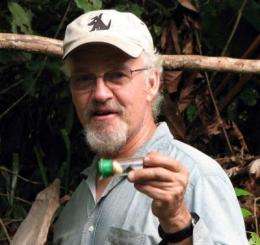Killer bees may increase food supplies for native bees

Aggressive African bees were accidentally released in Brazil in 1957. As "killer bees" spread northward, David Roubik, staff scientist at the Smithsonian Tropical Research Institute, began a 17-year study that revealed that Africanized bees caused less damage to native bees than changes in the weather and may have increased the availability of their food plants.
Scientists feared that dangerous swarms of Africanized bees would compete with native bees. Roubik took on the daunting task of sorting out the role of invading pollinators in tropical forests. In 1988, he set up bee traps in Sian Ka'an Biosphere Reserve—a vast area of mature tropical rainforest in Quintana Roo state on the Mexican Yucatan—with Rogel Villanueva-Gutiérrez, professor at the Colegio de la Frontera del Sur in Mexico. Africanized bees arrived in 1989.
"Our long view of the invasion shows that bees maintain higher-order evolutionary relationships with plants despite ups and downs in bee species within families," said Roubik. "Evolutionary relationships between bees and flowers, along with their flowering schedules, may be the fundamental currency that maintains this community."
Pollen from each plant species has a unique shape. Researchers compared pollen on bees in traps to pollen from flowers in the forest to determine which plants the bees were visiting.
Over the next 17 years, a severe drought and three hurricanes devastated native bees, but their populations rebounded each time. Africanized bees took over pollination of two plant families that had been important food sources for native bees: the cashew family and the spurge family. However, Pouteria, one of the plants native bees prefer, became more common. A few rare species of bees disappeared from traps later in the study.
Roubik cautions that native populations in less diverse areas might be less resilient to invasions. "Basically we're seeing 'scramble competition' as bees replace a lost source of pollen with pollen from a related plant species that has a similar flowering peak—in less-biodiverse, unprotected areas, bees would not have the same range of options to turn to."
More information: These results are published in the Biol. J. Linnean Soc.
Source: Smithsonian Tropical Research Institute















